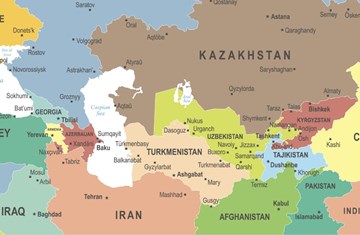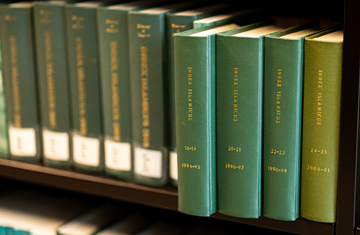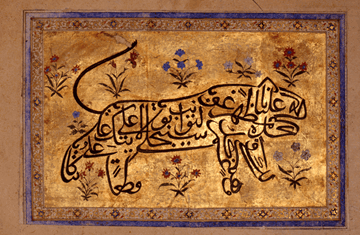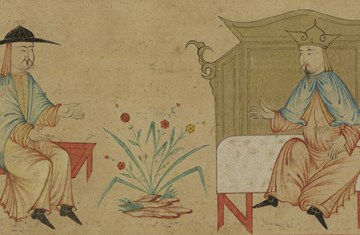IIS Co-sponsors Conference on Art, Architecture and Shi‘ism
IIS and the British Museum co-sponsored the conference, People of the Prophet’s House: Art, Architecture and Shi‘ism in the Islamic World, which took place at the British Museum from 26th – 28th March 2009. The conference was associated with the exhibition Shah ‘Abbas: The Remaking of Iran.
Three scholars from the IIS, Dr Shainool Jiwa, Nacim Pak-Shiraz and Dr Fahmida Suleman gave papers at the conference, which the latter also organised. Dr Farhad Daftary chaired a session on Fatimid contexts.
The conference aimed to answer two key questions: Who are the Shi‘a and whether we can distinguish art and material culture as being inherently Shi‘i? Papers had a broad historical and geographical scope, from West Africa to Spain and the Middle East. The conference brought together international scholars, who presented a wide range of material including mosque and shrine architecture, iconography, manuscript painting, cinema and ritual. Subjects were explored using various methodologies from art history, history and social anthropology.
Professor Azim Nanji opened the conference with the idea that the British Museum’s preservation of Muslim artefacts from all over the world provides us with themes that transcend both history and their geographical provenance.
Shainool Jiwa in her paper “Shi‘ism: Narratives, Images, Perspectives” provided a historical framework of Shi‘i Islam. Explaining Shi‘ism’s conceptual origins together with its contemporary expressions, she reminded the audience that Shi‘ism is an evolving pluralistic phenomenon. Its responses to other strands of Islam such as Sunnism and Sufism have also varied over time. Shi‘ism was situated by Dr Jiwa as possessing a cluster of characteristics. She also discussed the notion of the Ahl al-Bayt (the people of the Prophet’s house) and investiture of religious authority in that context. Dr Jiwa noted that reverence for the Ahl al-Bayt has transcended the Sunni-Shi‘a divide and has offered various opportunities of creating rapprochement between them.
Oleg Grabar, Professor Emeritus at Princeton has had a profound influence on the study of Muslim art. In his paper, “Can we identify Shi‘i Features in Art and Architecture?” Professor Grabar explored whether we can identify what we see with a single religious community? He tentatively concluded that there is a distinction between labelling an object as Shi‘i purely because of certain inscriptions and attributing Shi‘i provenance to forms and subjects. In the latter case, no inscription is necessary in order to attribute the object as Shi‘i. Professor Grabar stated that we must consider the receiver rather than the creator of an object in order to understand it. The visual language of the Fatimid mosque exteriors were predominantly designed to display the Shi‘a faith to the non-Shi‘a, albeit they were also a demonstration of their political power.
In her paper, “Writing about Faith: Epigraphic Evidence for the Development of Shi‘ism in Iran”, Sheila Blair, Professor at Boston College and Virginia Commonwealth University, predominantly focussed on the lusterware tile inscriptions produced in Kashan by Shi‘a potter families in the 12th – 13th centuries. Potters such as Muhammad ibn Abi Tahir and Abu Zayd contributed to multi-generational ensemble works for Shi‘i shrines at Qum and Mashhad. Blair noted that she was unable to find exclusively Shi‘i forms and decoration; it is only inscriptions that make artefacts understood as expressing Shi‘i beliefs.
Fahmida Suleman in her paper “The ‘Hand of Fatima’: Origins and Significance” explained how the ancient symbol of the open hand is found in many cultures. The ‘Hand of Fatima’ or ‘Khamsa’ is used in many parts of the Muslim world as an amulet. It is often attached to bridal garments and used in female contexts such as childbirth. The amulets are connected to Fatima al-Zahra, the daughter of Prophet Muhammad, who continues to occupy an elevated status among Sunnis and Shi‘is. However, the first official document mentioning the use of the ‘Hand of Fatima’ as an amulet dates much later from 1526 CE, in which Charles V banned the amulet’s use in Spain and ordered it to be replaced by the Christian cross. Thus, this document, together with pottery from 13th-century Muslim al-Andalus traces the ‘Hand of Fatima’ to that region. Dr Suleman’s paper therefore showed that the ‘Hand of Fatima’ transcended Sunni-Shi‘i confessional boundaries and was based on a long-standing pan-Islamic piety associated with Fatima al-Zahra.










